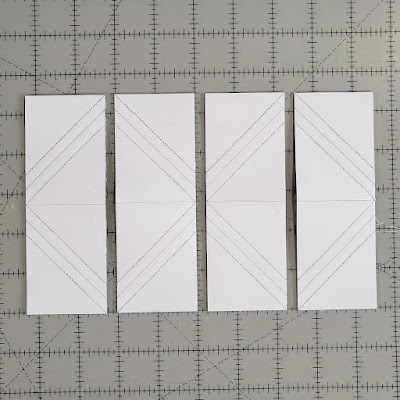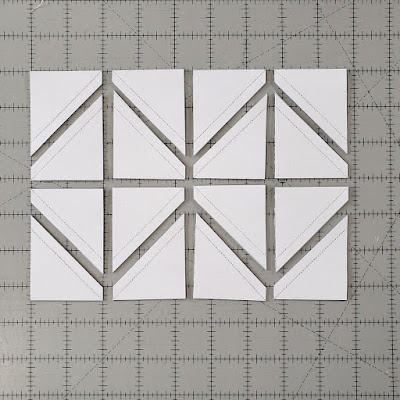If you have used my patterns in the past, you may be aware that I use the stitch-and-flip method often in my designs. This technique, also know as snowballed corners or lost corners, makes it easy to add a triangle to the corner of a unit without having to cut either a triangle or a non-rectangular/non-square shape to which to sew the triangle. It also avoid sewing along a cut bias edge.
How It Works
1. Start with a base shape, either a square or rectangle, to which you want to add a corner, and a smaller square of the fabric you want in the corner. The sides of the square should be 1/2" larger than the short sides of the triangles need to be in the finished quilt.
You'll be sewing across the square diagonally from corner to corner, so you may like to draw a line to guide your sewing. I like to use a mechanical pencil because it makes a fine line, which shows me more precisely where to stitch. (I have included links to alternatives to marking at the end of this post.)
2. With right sides together, tuck the square into the corner of the base shape, matching the edges in the corner.
3. Sew along the diagonal.
4. Fold the fabric back over the stitched line.

7. After pressing, open up the fold and cut away excess fabric from the corer, cutting 1/4" away from the seam. (Yes, I cut after I press. I have found that keeping the full base shape while pressing helps stabilize the shape and I'm less likely to distort the unit.)
Additional Tips and Thoughts
1. When the square is the same width as the base shape
You can also stitch-and-flip a corner when the square is the same width as the base shape. In this case I recommend starting to sew from the side (see white arrow below) rather than the corner. Starting from the corner sometimes leads to the corner getting caught in the machine.
2. Pay attention to the corner orientation
No amount of rotating a unit with a corner at the top right will turn the unit into one with a corner at the top left.
3. Trim as you go
When adding a second corner and the seam intersects the first corner, make sure you have trimmed away the excess fabric under the first corner before you add the second corner. That new seam will prevent you from pulling the first corner back all the way to trim away the layers beneath.
 |
| Oops! |
4. Why you should sew accurately rather than count on trimming
You may be tempted to sew a little off the diagonal so that when you fold back the corner it extends a little past the corner of the base shape, then trim everything even with the base shape.
This is fine if the the points of the triangle in the corner do not need to meet a particular part of whatever unit will be beside it.
If the points are meant to line up with some other element, you need to be accurate. Consider the example below (this is a random example, not from any particular pattern).
Here's the same unit, but with the corner just a little larger, from using a larger square as "fudge room".


















































